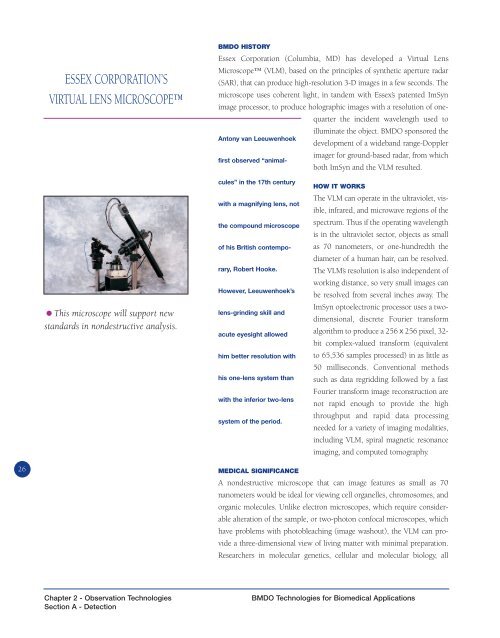bmdo technologies for biomedical applications - MDA Technology
bmdo technologies for biomedical applications - MDA Technology
bmdo technologies for biomedical applications - MDA Technology
Create successful ePaper yourself
Turn your PDF publications into a flip-book with our unique Google optimized e-Paper software.
ESSEX CORPORATION’SVIRTUAL LENS MICROSCOPE• This microscope will support newstandards in nondestructive analysis.BMDO HISTORYEssex Corporation (Columbia, MD) has developed a Virtual LensMicroscope (VLM), based on the principles of synthetic aperture radar(SAR), that can produce high-resolution 3-D images in a few seconds. Themicroscope uses coherent light, in tandem with Essex’s patented ImSynimage processor, to produce holographic images with a resolution of onequarterthe incident wavelength used toilluminate the object. BMDO sponsored theAntony van Leeuwenhoekdevelopment of a wideband range-Dopplerimager <strong>for</strong> ground-based radar, from whichfirst observed “animal-both ImSyn and the VLM resulted.cules” in the 17th centurywith a magnifying lens, notthe compound microscopeof his British contemporary,Robert Hooke.However, Leeuwenhoek’slens-grinding skill andacute eyesight allowedhim better resolution withhis one-lens system thanwith the inferior two-lenssystem of the period.HOW IT WORKSThe VLM can operate in the ultraviolet, visible,infrared, and microwave regions of thespectrum. Thus if the operating wavelengthis in the ultraviolet sector, objects as smallas 70 nanometers, or one-hundredth thediameter of a human hair, can be resolved.The VLM’s resolution is also independent ofworking distance, so very small images canbe resolved from several inches away. TheImSyn optoelectronic processor uses a twodimensional,discrete Fourier trans<strong>for</strong>malgorithm to produce a 256 x 256 pixel, 32-bit complex-valued trans<strong>for</strong>m (equivalentto 65,536 samples processed) in as little as50 milliseconds. Conventional methodssuch as data regridding followed by a fastFourier trans<strong>for</strong>m image reconstruction arenot rapid enough to provide the highthroughput and rapid data processingneeded <strong>for</strong> a variety of imaging modalities,including VLM, spiral magnetic resonanceimaging, and computed tomography.26MEDICAL SIGNIFICANCEA nondestructive microscope that can image features as small as 70nanometers would be ideal <strong>for</strong> viewing cell organelles, chromosomes, andorganic molecules. Unlike electron microscopes, which require considerablealteration of the sample, or two-photon confocal microscopes, whichhave problems with photobleaching (image washout), the VLM can providea three-dimensional view of living matter with minimal preparation.Researchers in molecular genetics, cellular and molecular biology, allChapter 2 - Observation TechnologiesSection A - DetectionBMDO Technologies <strong>for</strong> Biomedical Applications




